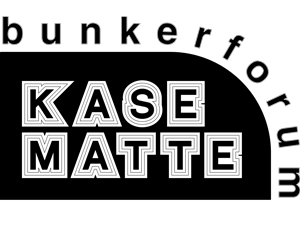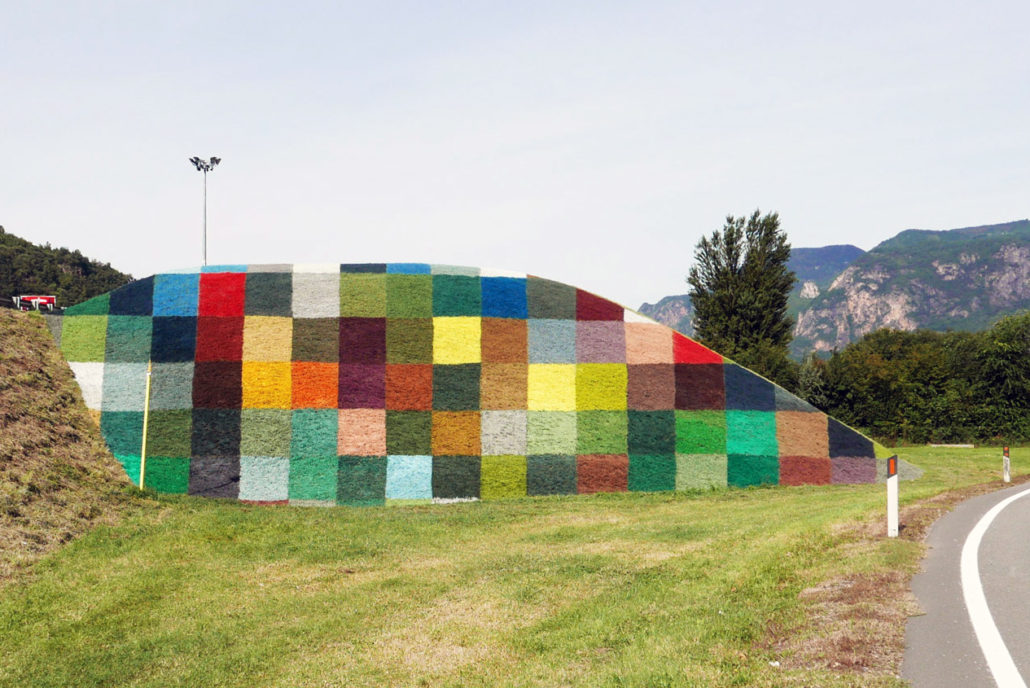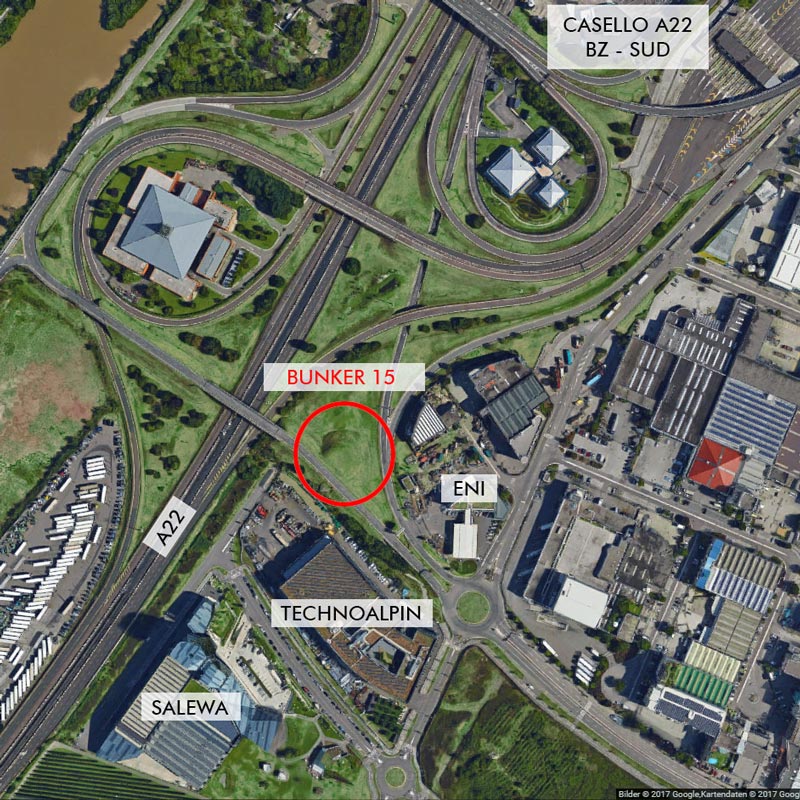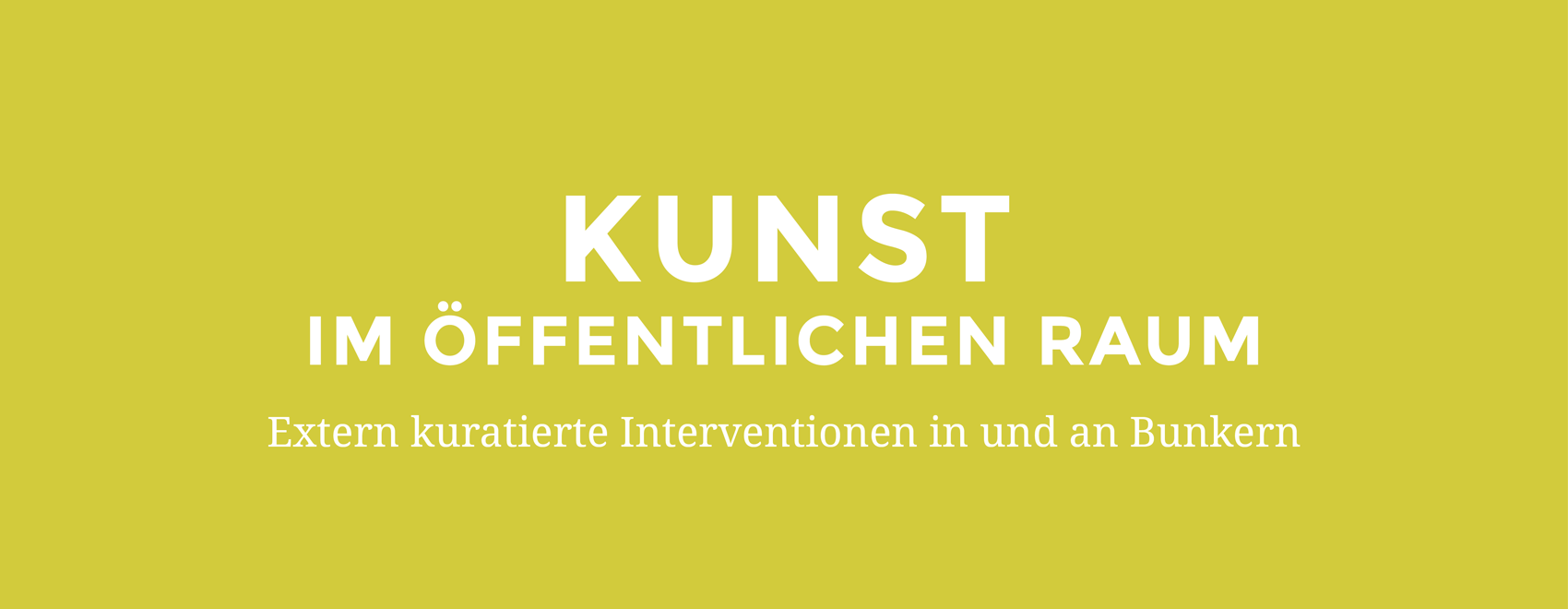Bunker now #3
CAMOUFLAGE LAWN (Tarnrasen)
by CATRIN BOLT
INAUGURATION PHASE 3 “PIXELATE” ON OCTOBER 10 th 2020 AT 16 PM
Brief description:
On a grass hill in the south of Bolzano, under which an infantry bunker from the fascist era is located, camouflage patterns are applied on the hill’s surface over three years that make it optically disappear and referring to the bunker below. These camouflage patterns make the bunker hill not less visible, but rather perceivable as a unit and specially conspicuous. In this year’s third and final stage, the hill is optically “pixelated”.
PHASE 1: October 2017
PHASE 2: October 2018
PHASE 3: October 2019 postponed to October 2020 due to bad weather
Location: Bunker Nr. 15, South Bolzano
ARTIST STATEMENT:
The hill in the middle of the freeway and expressway triangle in South Bolzano does not suggest anything about the bunker below. Overgrown with grass and bushes, it camouflages the bunker perfectly.
As an artist who deals with the political dimensions of our everyday spaces, I was invited to draw artistic attention to the bunker below. To camouflage the hill, i.e. nature, again, is absurd at first. A grass hill that camouflages itself. A continuation of the absurdity of forgetting in dealing with the historical heritage, thus camouflaging the act of forgetting. Thus the hill is to be dissolved or disappear in three stages in different ways. But it is only through this camouflage that it becomes visible.
In the first design, “dazzle”, it is disassembled into its unit and, depending on the angle of view and light situation, partly merges into the surroundings. Apart from the visual effect, the patterns are reminiscent of road markings – lines that systematically run through the landscape and capture it for themselves through their functional aspect.
In another design, a classic camouflage pattern is applied to disguise it as “nature”, and in the third stage the hill is completely “pixelated”, as is usual for inaccessible territory on Google Earth, for example military installations.
Text & Photo: © Catrin Bolt
Press release:
South Tirol has over 450 bunkers, military defense constructions, pillboxes and fortified shelters from the Second World War, meant to defend Italy against Germany, its own allay at the time. This war was a dark time in the region’s history and with hard consequences for the local population. Understandably, the public and authorities meet those constructions with holstered fascination and open rejection.
But to leave them to oblivion or erase them, any effort to get them out of sight also runs the danger of white washing history. We are faced with a similar dilemma as the South of the United States with their monuments to confederate soldiers. There should be a way to remember the darkest moments in history without denying the facts but also without glorifying them. The way to do this is with context, education and critical reconditioning in order to generate awareness.
Curator Victoria Dejaco, who had been invited by the association Verein Kasematte Bunkerforum to contribute to the conversation, has attempted a first step in this direction. The site of Bunker 15 at Bozen Süd was chosen for a first intervention with artist Catrin Bolt in 2016. She had already realized memorials in Graz (2013) and Vienna (2014) in the context of the Jewish history of those cities during the Second World War and was predestined to take up the task. In 2015 she also won the Otto Maurer Prize, the most prestigious prize for young art in Austria.
The Bunker 15 in the South of Bolzano next to the highway A22 had been hidden under a hill of earth after in the 1990s during the construction of the MeBo. It is part of a system of several constructions meant to work together. Its twin building is freestanding and in tact only a few hundred meters to the East.
Matching the situation of the bunker, now hidden under earth, Catrin Bolt developed a project around the topic of hiding and camouflaging. The entire area will be covered in camouflage patterns in order to draw attention to the inconspicuous hill. The military form of disguise will hence be somewhat inverted in its function. It is planned to transform the hill three times in the course of the upcoming year. Once with an ordinary military camouflage, once with the dazzle effect, a pattern that deconstructs the object it aims to conceal and once with a camouflage of the tech era: the “pixel out” effect used on Google Maps to render (military) territory unrecognizable.
Victoria Dejaco
Graz, 22.10.2017
born 1979 in Friesach / Austria, lives and works in Vienna / Austria.
Education and activities:
1997 – 2003 Studies at the Academy of Fine Arts Vienna (Diploma)
1999 – 2003 Cooperation with Marlene Haring as Halt+Boring
Awards and grants:
2015 – Otto Mauer Prize 2015 – 1st place for the realization of the memorials for Marie Jahoda and Elise Richter, competition of the University of Vienna to honor female scientists in the Arkadenhof
2014 – 1st place, competition film about the tunnel Gusen in St.Georgen, BIG Art (AUT)
Workshops and scholarships:
2016 – Scholarship for Video and Media Art, Yogyakarta (IND)
2013 – “Curator’s Network”, Kunsthalle Exnergasse, Vienna (AUT)
Projects on your own initiative:
2015 – Georgian-Austrian exhibition, organized and curated together with Giorgi Okropiridse, galerie nectar, Tbilisi (GEO) and D.U.O., Vienna (AUT)
2013/14 – international symposium and exhibition at the Madonnenschlössl, in cooperation with Edith Payer, Madonnenschlössl, Bernstein and Kunstraum Schauplatz, Vienna (AT)
Solo exhibitions and permanent presentations in public space:
2017 – “capitalist imperative”, rhizome, Graz (AUT) “anal birth”, Neue Galerie, Innsbruck (AUT)
2016 – “Holz bunt”, A307, invited by Eric Kläring, Vienna (AUT) “Sandblasting pictures”, monuments to Marie Jahoda and Elise Richter, Arcade Court of the University of Vienna, Vienna (AUT)
“Pameran satu hari”, Sewon Art Space, Yogyakarta (IND)









